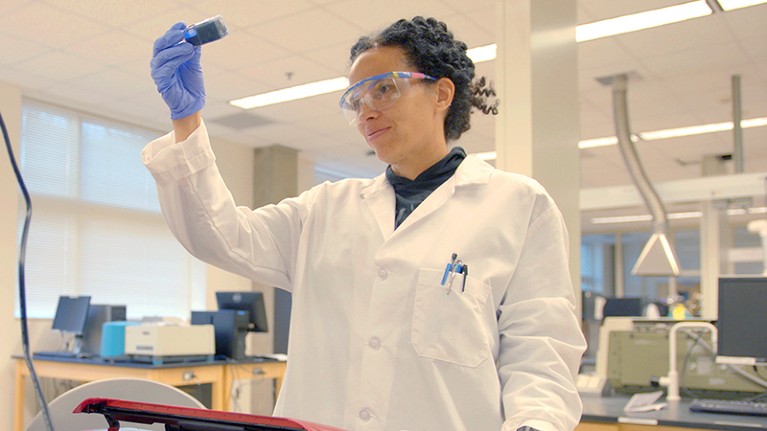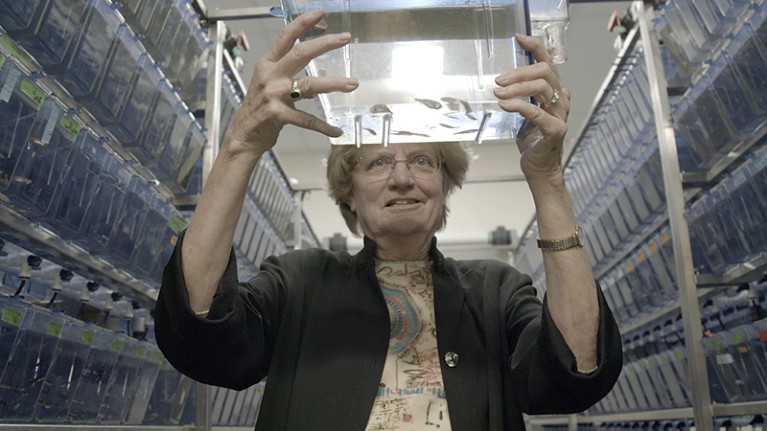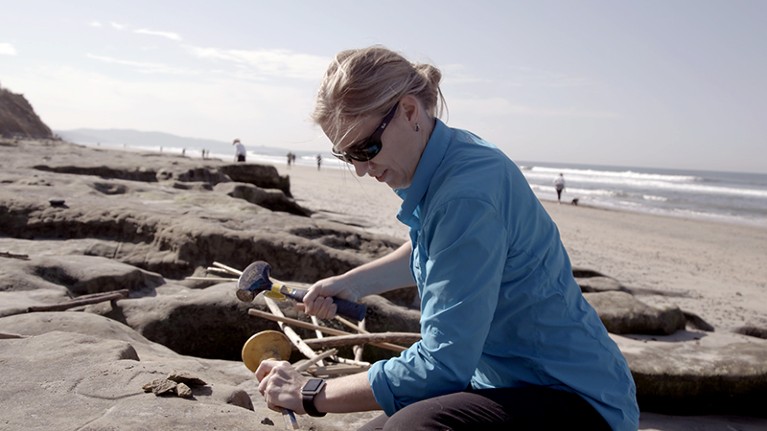Three extraordinary women run the gauntlet of science — a documentary (original) (raw)

Chemist Raychelle Burks shares her experience of gender bias and racial discrimination in the film Picture a Scientist.Credit: Uprising, LLC
Picture a Scientist Film by Sharon Shattuck and Ian Cheney Uprising Production (2020). Screening online until 26 June at https://www.pictureascientist.com
Ask people to picture a scientist, and what do many imagine? A white man in a white lab coat, sadly.
The film Picture a Scientist shows why. It chronicles, through the stories of three extraordinary female researchers, the gender and racial biases that drive so many people out of science. All the usual suspects are here: systemic racism, institutional bias, sexual harassment. Together, they tell so many aspiring researchers the lie that they do not belong.
The film-makers interweave interviews with startling statistics. Women receive 50% of the bachelor’s degrees in science and technical fields in the United States, yet comprise only 29% of people employed in those fields. The pipeline of people interested in science is full at the start, but it leaks over time because of discrimination and harassment, says Paula Johnson, the president of Wellesley College in Massachusetts.
Implicit bias is pervasive. Men are preferred to women even if they have the same accomplishments. Psychologists have shown this by testing scientists’ responses to fictitious CVs that are identical other than coming from ‘John’ or ‘Jennifer’, or CVs that include, or scrub, mention of the applicant’s status as a member of a minority racial group. Even social scientists who are aware of their own bias do not overcome it, as they admit on camera.
The iceberg analogy for sexual harassment is apt. It holds that only a fraction of harassment — obvious things such as sexual assault and sexual coercion — rises into public consciousness and awareness. The rest of the iceberg is buried deep. It includes the more insidious and pernicious attacks, from calling someone horrifying names to sabotaging their lab equipment. “I remember the first time he called me a ...” is one of many memorable lines in the film, spoken by a former graduate student of her adviser. And there’s a whole other iceberg of covert racial aggression lurking beneath the overt (see, for example, go.nature.com/3hfuco8).
Raychelle Burks has fought harder than most. Burks, an analytical chemist now at the American University in Washington, DC, specializes in developing techniques to detect explosives. We see Burks working in the lab, ebullient in T-shirt and jeans, demonstrating chemistry to students. A Black woman in academia, Burks once got mistaken for a janitor while working at her desk. The higher she rises, the fewer Black scientists there are. Which is why she constantly works in science communication and outreach — many know Burks as Dr Rubidium — so that kids can see a scientist who is a person of colour.
The film-makers follow Burks to a chemistry meeting in Canada, where she talks about diversity to a room of mostly white faces. She tells them that we all code-switch to an extent, changing from our personal to professional personas to interact with other scientists. But no one ever asked, she says, why one version of professionalism — suits, straight hair — is deemed more appropriate than Burks’.

Biologist Nancy Hopkins campaigned for equal treatment at work for female scientists.Credit: Uprising, LLC
That’s as far as Picture a Scientist ventures into the intersectional challenges facing many scientists. Its two other protagonists are white women with their own compelling stories.
Biologist Nancy Hopkins was shocked when Francis Crick once put his hands on her breasts as she worked in the laboratory. By the time she became a full professor at the Massachusetts Institute of Technology (MIT) in Cambridge, she knew the problems were both deep-rooted and less obvious. When she couldn’t get enough lab space to do her research on zebrafish development, she used a tape measure to prove that male faculty had substantially more space than female faculty. We follow along as Hopkins walks those same hallways today, eyeing the dimensions and tallying up the inequalities.
She recruited colleagues to gather much more data. The culmination was a landmark 1999 study on gender bias in MIT’s school of science (see go.nature.com/2ngyiyd), which reverberated across US higher education and forced many administrators to confront entrenched discrimination. Yet Hopkins would rather have spent that time doing science, she relates.

Jane Willenbring, a geologist at the Scripps Institution of Oceanography, discusses her experiences in the film Picture a Scientist.Credit: Uprising, LLC
The third story comes from Jane Willenbring, a geoscientist who in 2016 filed a formal complaint accusing her PhD adviser, David Marchant, of routinely abusing her during fieldwork in Antarctica years before. Marchant, who has denied the allegations, was sacked from his post at Boston University in April 2019 after an investigation. Picture a Scientist brings Willenbring together with Adam Lewis, who was also a graduate student during that Antarctic field season and witnessed many of the events. Their conversations are a stark reminder of how quickly and how shockingly the filters that should govern work interactions can drop off, especially in remote environments. Lewis tells Willenbring he didn’t realize at the time that she had been bothered, because she did not show it. “A ton of feathers is still a ton,” she says.
In stark contrast, the film shows us Willenbring, now at the Scripps Institution of Oceanography in San Diego, California, with two of her students working along the coastal cliffs. Slowly, carefully, collaboratively, they drill samples out of the rocks, to extract clues to how California might prove resilient to climate change. It struck me as fitting — given Willenbring’s resilience and the strength of the scientists profiled in this film.